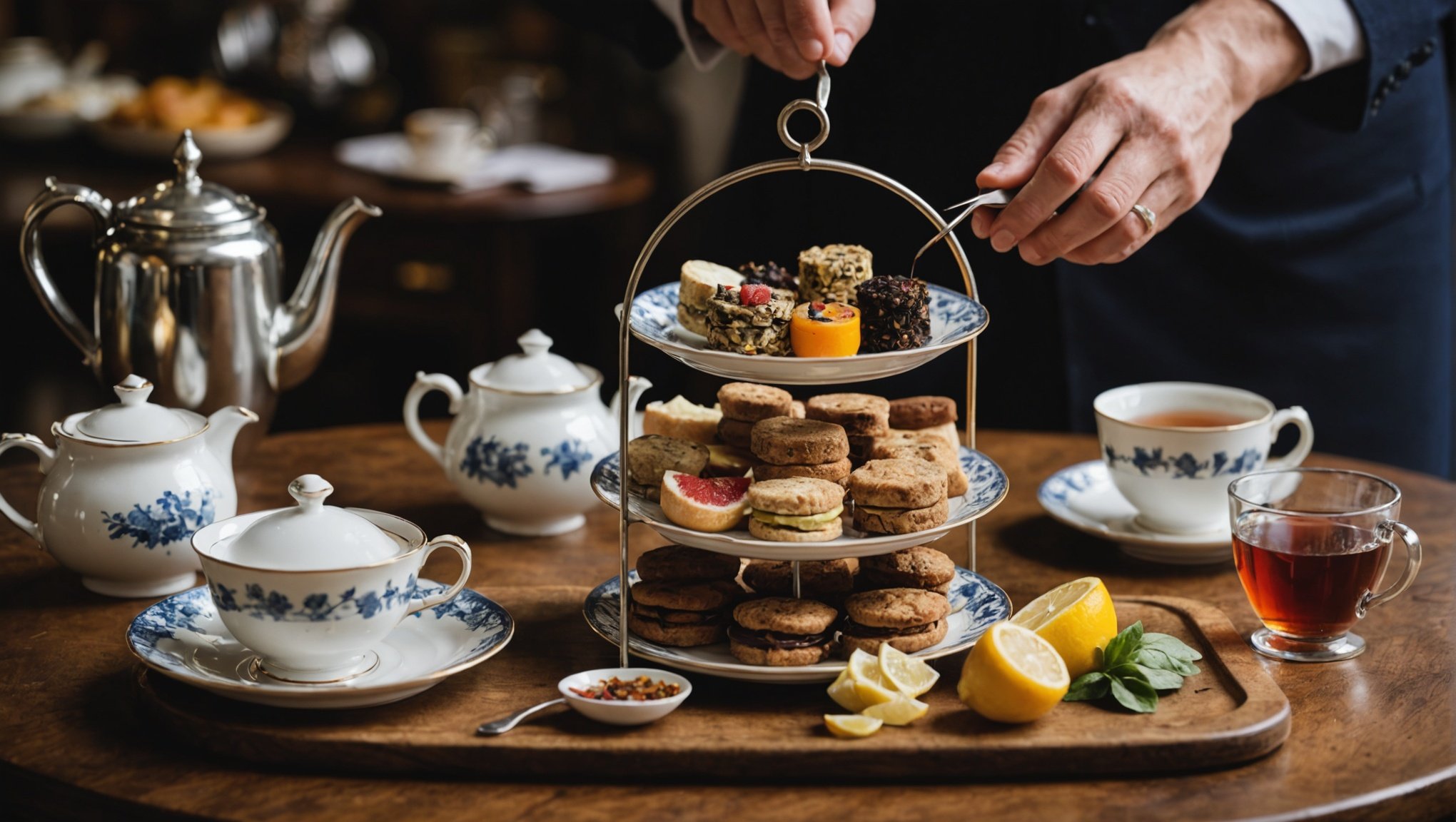Looking to enhance your British restaurant’s appeal? Tea pairings can elevate your menu, offering guests a unique dining experience. From traditional scones paired with Earl Grey to innovative seafood dishes complemented by green tea, exploring these combinations can delight the palate. Discover how to creatively infuse tea into your offerings, enhancing flavors while paying homage to British culinary heritage. Transform your menu from ordinary to extraordinary, inviting guests to savor the sophistication of thoughtfully paired tea and food.
Understanding the Cultural Significance of Tea in British Cuisine
Exploring the cultural significance of tea in Britain offers insight into its enduring place in society.
Also to read : Top Essential Tools You Need to Launch a Thriving Catering Business
Historical Journey of Tea to Britain
Tea's introduction to Britain dates back to the 17th century, when it was first imported by the East India Company. Initially a luxury item, it quickly gained popularity across different social classes. This historical journey underscores tea's transformation from an exotic novelty to a staple in British dining traditions.
Role of Tea in Traditional British Meals
Tea plays a crucial role in traditional British meals, often serving as a centerpiece for gatherings. Afternoon tea, with its assortment of sandwiches and pastries, exemplifies this tradition. High tea, a more substantial meal, demonstrates how tea integrates into daily life, illustrating its cultural significance.
This might interest you : Top Proven Strategies to Safeguard Your Busy City Bar Against Theft
Modern Perceptions of Tea in British Culture
In contemporary Britain, tea remains a symbol of comfort and hospitality. Its cultural significance endures, adapting to modern tastes with a variety of blends and flavors. Despite changes, tea continues to be a cherished part of British dining traditions.
- Cultural Significance
- Comfort
- Hospitality
- Tradition
This multifaceted role of tea highlights its lasting impact on British culture and dining.
Practical Tips for Tea Pairings with Classic British Dishes
Discovering the perfect tea pairings can elevate your experience of classic British dishes. Understanding the flavor profiles of these dishes is key to selecting the right tea.
Identifying Flavor Profiles
British cuisine is known for its hearty and comforting flavors. For example, fish and chips offer a savory, crispy texture, while Shepherd's Pie provides a rich, meaty taste. Recognizing these profiles helps in choosing complementary teas.
Suggested Tea Types
Pairing teas with these dishes enhances the dining experience. For fish and chips, a green tea with its fresh, slightly grassy notes balances the dish's oiliness. Shepherd's Pie pairs well with a robust black tea, which complements its savory depth.
Balancing Flavors
When selecting tea, consider the dish's dominant flavors. Here are some tips:
- Green Tea: Best with light, fresh dishes like salads or fish.
- Black Tea: Ideal for rich, savory meals such as meat pies.
- Herbal Tea: Complements sweet desserts like scones.
Finding the right balance between tea and food enhances both elements, creating a harmonious dining experience. Understanding and experimenting with these combinations can transform your appreciation of British cuisine.
Innovative Menu Ideas Featuring Tea
Exploring the world of tea-infused dishes opens up a realm of creative possibilities for British restaurant concepts.
Tea-Infused Appetizers and Entrees
Incorporating tea into appetizers and entrees can add a unique twist to traditional dishes. For instance, a green tea-infused soup offers a refreshing start to any meal, while a black tea-marinated chicken provides a depth of flavor that enhances the savory profile of the dish. These creative menu ideas not only surprise diners but also highlight the versatility of tea in cooking.
Unique Desserts Incorporating Tea Flavors
Desserts present another opportunity to showcase tea's potential. Consider a matcha-infused cheesecake, where the earthy notes of matcha complement the creamy texture. Alternatively, an Earl Grey-flavored chocolate mousse provides a sophisticated finish to a meal, blending the citrusy hints of bergamot with rich chocolate.
Seasonal Tea-Themed Menu Changes
Adapting menus to the seasons with tea-infused dishes can keep offerings fresh and engaging. In spring, a jasmine tea panna cotta might capture the essence of blooming flowers, while autumn could feature a chai-spiced apple tart. Such creative menu ideas ensure that tea remains a dynamic element in British restaurant concepts.
- Tea-Infused Dishes
- Creative Menu Ideas
- British Restaurant Concepts
Customer Experiences with Tea Pairings
Exploring how diners perceive tea pairings can provide valuable insights for enhancing the dining experience.
Collecting and Analyzing Customer Feedback
Gathering customer testimonials is crucial in understanding the impact of tea pairings. Restaurants often use surveys and comment cards to collect feedback. Analyzing this data reveals trends and preferences, helping refine offerings. For instance, many diners appreciate how a black tea can enhance the richness of a meaty dish, as noted in several testimonials.
Successful Case Studies
Highlighting successful implementations of tea pairings can inspire other establishments. One notable case involves a London restaurant that introduced a seasonal tea-infused menu. Customers praised the innovative approach, and the restaurant reported increased patronage. This success story underscores the potential benefits of thoughtful tea pairings for enhancing the dining experience.
Testimonials from Diners
Diners' feedback on tea pairings often highlights their transformative effect. One diner remarked, "The green tea perfectly balanced the flavors of my meal, elevating the entire experience." Such testimonials emphasize the importance of well-chosen tea pairings in creating memorable dining moments.
- Customer Testimonials
- Dining Experience
- Tea Pairings Feedback
Expert Opinions on Tea and Food Pairing
Exploring the insights of culinary experts can enhance your understanding of tea pairings.
Interviews with Chefs Specializing in Tea Pairings
Culinary expert insights reveal that the art of tea and food pairing is both science and creativity. Chef Emily Thompson, known for her innovative tea-infused menus, emphasizes the importance of balance. "Tea can elevate a dish by complementing or contrasting its flavors," she notes. This approach is echoed by Chef Raj Patel, who highlights the role of food pairing advice in crafting memorable dining experiences. "Understanding the flavor profiles of both the tea and the dish is crucial," he advises.
Tips from Culinary Experts on Enhancing the Dining Experience
Experts suggest several strategies for successful pairings:
- Experiment with Contrasts: Pair bold teas with subtle dishes.
- Match Intensity: Align the strength of tea with the dish's flavors.
- Consider Aromatics: Use tea's aroma to enhance the meal's sensory appeal.
These tips underscore the value of restaurant consultation in menu development, ensuring that each pairing is thoughtfully curated.
Importance of Expert Guidance in Menu Development
Incorporating culinary expert insights into menu planning can transform a restaurant's offerings. Expert guidance helps chefs navigate the complexities of tea pairings, providing food pairing advice that enhances both the menu and the overall dining experience. This collaboration is vital for creating dishes that resonate with diners, making tea an integral part of the culinary journey.
Recipes for Tea-Infused Dishes
Exploring the art of cooking with tea can elevate your culinary creations.
Step-by-Step Recipes for Tea-Infused Main Courses
Creating tea-infused main courses allows you to incorporate unique flavors into British cuisine recipes. A black tea-marinated chicken is a simple yet flavorful dish. Start by brewing a strong cup of black tea, then mix with soy sauce, honey, and garlic. Marinate the chicken for at least 2 hours before roasting. This method ensures the tea's rich notes permeate the meat.
Creative Tea-Based Dessert Recipes
For desserts, tea recipes can add a delightful twist. Try a matcha panna cotta. Dissolve gelatin in warm milk, then whisk in sugar and matcha powder. Combine with cream and let it set. This dessert highlights the earthy tones of matcha, offering a refreshing finish.
Tips for Brewing and Integrating Tea into Dishes
- Brew Strong: For cooking, use a stronger brew to ensure the flavor stands out.
- Experiment: Try different teas like Earl Grey or jasmine for varied aromas.
- Balance Flavors: Match the tea's intensity with the dish's ingredients.
Incorporating tea recipes into your repertoire enhances your ability to create memorable British cuisine recipes.
Marketing Tips for Promoting Tea Pairings
Strategies to effectively market tea pairings in your restaurant.
Strategies for Marketing Tea Pairings
To successfully market tea pairings, focus on creating a strong narrative around your offerings. Highlight the cultural significance of tea and its role in enhancing the dining experience. Consider crafting stories that resonate with your audience, emphasizing the unique flavors and experiences your tea pairings provide.
Utilizing Social Media
Social media is a powerful tool for promoting tea pairings. Share visually appealing images of your dishes paired with tea, accompanied by engaging captions. Use platforms like Instagram and Facebook to announce new menu items, and encourage customers to share their experiences. This can increase visibility and attract a broader audience to your restaurant.
Engaging Customers Through Tea-Centric Events
Hosting tea-centric events is an excellent way to engage customers and showcase your tea pairings. Organize tasting sessions or themed dinners where guests can explore different tea pairings. Offer special promotions or discounts during these events to encourage participation. Such initiatives not only promote your menu but also foster a sense of community and loyalty among your patrons.
- Social Media: Leverage platforms for wider reach.
- Storytelling: Create engaging narratives.
- Events: Host tastings and themed dinners.
Implement these strategies to effectively market your tea pairings, enhancing both customer engagement and restaurant success.
Future Trends in Tea and Dining
Exploring the evolving landscape of tea in British dining.
Emerging Trends in Tea Consumption
The future of British cuisine is being shaped by innovative tea offerings. Restaurants are increasingly experimenting with tea innovation, incorporating unique blends and flavors into their menus. This trend reflects a growing consumer interest in diverse tea experiences, from traditional brews to exotic infusions.
Predictions for the Future of Tea in British Dining
As dining trends evolve, tea is expected to play a pivotal role. Predictions suggest a rise in sustainable tea sourcing, with a focus on organic and fair-trade options. Additionally, tea bars and tea-tasting events are likely to become more popular, offering customers a chance to explore a wide range of flavors.
Staying Ahead with Innovative Tea Offerings
To stay competitive, restaurants should embrace tea innovation. Consider the following strategies:
- Diversify Menu: Introduce seasonal and themed tea pairings.
- Customer Engagement: Host interactive tea workshops.
- Sustainability Focus: Highlight eco-friendly tea choices.
By integrating these dining trends, establishments can enhance their appeal and ensure they remain at the forefront of the future of British cuisine. Engaging customers with innovative tea offerings not only enriches their dining experience but also strengthens brand loyalty.






